
About UsThe Numismatic Bibliomania Society is a non-profit organization promoting numismatic literature. For more information please see our web site at coinbooks.org SubscriptionsThose wishing to become new E-Sylum subscribers (or wishing to Unsubscribe) can go to the following web page link MembershipThere is a membership application available on the web site Membership Application To join, print the application and return it with your check to the address printed on the application. Membership is only $15 to addresses in the U.S., $20 for First Class mail, and $25 elsewhere. For those without web access, write to: David M. Sundman, Secretary/TreasurerNumismatic Bibliomania
Society AsylumFor Asylum mailing address changes and other membership questions, contact David at this email address: dsundman@LittletonCoin.com SubmissionsTo submit items for publication in The E-Sylum, just Reply to this message, or write to the Editor at this address: whomren@coinlibrary.com
BUY THE BOOK BEFORE THE COINYou won't regret it! |
- WAYNE'S WORDS: THE E-SYLUM MARCH 13, 2011
- CZAHOR MAILBID SALE XV TO FEATURE NUMISMATIC LITERATURE
- NEW BOOK: COIN COLLECTING FOR THE NEXT GENERATION
- THE MAKING OF THE SECRET HISTORY OF THE FIRST U.S. MINT
- CORRECTION: ENGRAVED PATTERN GOLD DOLLAR INSCRIPTION
- ON WIRE, KNIFE AND ROLLED RIMS
- SARAH SOPHIA BANKS (1744-1818)
- QUERY: WHO WORKED AT STACK'S IN 1966?
- QUERY: FIRST THREE BASSO PHILIPPINE COIN ALBUMS SOUGHT
- MORE ON DAMASCENED MEDALS
- MORE ON F. GORDON FROST
- SOME PHOTOS OF STEVE TANENBAUM
- QUERY: REVIEWS OF MOSSMAN BOOK SOUGHT
- NOTES FROM E-SYLUM READERS: MARCH 13, 2011
- HERBERT IVES AND THE AMERICAN NUMISMATIC SOCIETY
- GAO RECOMMENDS REPLACING DOLLAR NOTE WITH COINS
- EDITORIAL COMMENTS ON ABOLISHING THE $1 BILL
- WAYNE'S NUMISMATIC DIARY: MARCH 13, 2011
- 1937 KING GEORGE VI GOLD MATT PROOF COINS
- THE BANK OF GREECE MUSEUM
- SPANISH TOWN REINTRODUCES PESETAS TO BOOST ECONOMY
- SRI LANKA'S 2011 AIR FORCE COMMEMORATIVE COIN
- JAPANESE "MONEY ARTIST" YASUMASA MORIMURA
- METAL DETECTORIST'S LEICESTER GOLD COIN FIND
- FEATURED WEB SITE: THAMES MUDLARKS
WAYNE'S WORDS: THE E-SYLUM MARCH 13, 2011

No new email subscribers this week. We have 1,406 email subscribers, plus 119 followers on Facebook, including Lynwood Leverette and Nancy Wilson.
This week we open with information on an upcoming literature sale by Ray Czahor, a new book announcement, and some background on the research behind the new Augsburger/Orosz book on The Secret History of the U.S. Mint.
Other topics include wire rims and related features, the Bank of Greece Museum, damascened medals, and numismatic personalities including Herbert Ives and the strong-willed woman who built the British Museum's stunning collection of early U.S. and colonial coins.
To learn more about Hy Hintermeister, left- and right-handed coin engravers, Leper colony coin albums, and a Nobel Prize medal in chocolate, read on. Have a great week, everyone!
Wayne Homren
Numismatic Bibliomania Society
CZAHOR MAILBID SALE XV TO FEATURE NUMISMATIC LITERATURE
Because I have such a large number of books to sell from C.M. Nielsen's collection and I just received two consignments of books, I have decided the next Mailbid XV will be a books-only sale. The list should be over 400 lots and be sent out before the end of March.
The subjects will be heavy on Philippine topics as well as world and US currency and notgeld and other WWII topics. I intend to send Mailbid XV to those collectors who bid on books in the last two sales. If you haven't bid but would like a copy of this book list, please let me know as soon as possible and I will mail you one.
Ray Czahor
Cookie Jar Collectibles
Box 597
Columbia, MD 21045
Telephone: 301-604-9225
Email: cookiejarpi@verizon.net
NEW BOOK: COIN COLLECTING FOR THE NEXT GENERATION
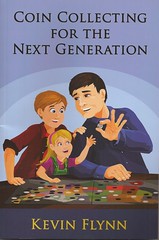 A new book created to help hobbyists introduce the enjoyment of numismatics to children, Coin Collecting for the Next Generation, is now available. Written by prolific author Kevin Flynn of Lumberton, New Jersey, the 128-page, softcover book gives collectors, dealers and show organizers successful ideas for getting children involved in coin collecting to help the hobby grow in future years.
A new book created to help hobbyists introduce the enjoyment of numismatics to children, Coin Collecting for the Next Generation, is now available. Written by prolific author Kevin Flynn of Lumberton, New Jersey, the 128-page, softcover book gives collectors, dealers and show organizers successful ideas for getting children involved in coin collecting to help the hobby grow in future years.
"This book presents many ideas for making coin shows family and kid friendly. Readers get information about how to make coins fun and exciting for young collectors. Coins also are a good teaching tool on many different subjects including history, math and drawing," said Flynn who now has authored or co-written a total of 38 books about numismatic topics.
The Professional Numismatists Guild (www.PNGdealers.com) provided a $2,500 grant for Flynn to create the book and promote coins to potential young numismatists.
"The PNG leaders understand the importance of the next generation and they clearly want to get kids involved to help our hobby," said Flynn.
The book contains articles written by nearly a dozen contributors including former PNG President Harvey Stack and former American Numismatic Association Presidents Kenneth E. Bressett and David L. Ganz.
"Kevin's book is wonderful. PNG, as well as other trade organizations, should be committed to the future of our hobby. We have to tell our kids about coins. My Dad taught me, and the enjoyment of the hobby led me to where I am today," said PNG President Paul Montgomery.
Coin Collecting for the Next Generation is available for $12.95 per copy. Contact Kyle Vick at Stanton Books and Stone Mountain Supply, 1570 Holcomb Bridge Rd., Suite 120, Roswell, GA 30076. Phone: (800) 828-8306. Online at www.StantonBooks.com. Discounts are available for quantity orders.
FREE SHIPPING ON YOUR WHITMAN ORDER!
THE MAKING OF THE SECRET HISTORY OF THE FIRST U.S. MINT
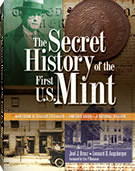 âAuthors are notorious for underestimating the work that must be done in order to write a book,â write Joel Orosz and Leonard Augsburger in the preface to The Secret History of the First U.S. Mint (subtitled How Frank H. Stewart Destroyedâ"And Then Savedâ"A National Treasure), âbut in the long history of publishing, few writers have ever misjudged the magnitude of the task before them quite so spectacularly as those who wrote the volume you now hold in your hands. Recounting how this project expandedâ"perhaps âmetastasizedâ would be more accurateâ"from a modest article into a profusely illustrated tome may prove instructive to anyone contemplating a seemingly simple literary project.â
âAuthors are notorious for underestimating the work that must be done in order to write a book,â write Joel Orosz and Leonard Augsburger in the preface to The Secret History of the First U.S. Mint (subtitled How Frank H. Stewart Destroyedâ"And Then Savedâ"A National Treasure), âbut in the long history of publishing, few writers have ever misjudged the magnitude of the task before them quite so spectacularly as those who wrote the volume you now hold in your hands. Recounting how this project expandedâ"perhaps âmetastasizedâ would be more accurateâ"from a modest article into a profusely illustrated tome may prove instructive to anyone contemplating a seemingly simple literary project.â
In February of 2006, the authorsâ attention was fixed on topics well-removed from Frank H. Stewart and the first U.S. Mint. Leonard Augsburger was focused on another city (Baltimore) in another century (the 1900s), in the homestretch of research for his book, Treasure in the Cellar, the first thoroughly documented history of the great gold coin hoard literally unearthed in Depression-era Baltimore. Joel J. Oroszâs attention was fixed on Americaâs âsmall beginningâ in coinage, the 1792 half disme. It was this diminutive coin, of course, that served as the (unseen) focal point of John Ward Dunsmoreâs celebrated painting, Washington Inspecting the First Money Coined by the United States. Like most numismatists, the authors knew just enough about Dunsmoreâs canvas to be dangerous: it was painted around the time of World War I; it was commissioned by the man who wrote the History of the First United States Mint; and it represented the triumph of artistic license over historical accuracy.
Orosz, still fixated upon half dismes, began to ask logical questions about the Dunsmore painting, such as whether the artist may have painted more than one version, and if so, where the original and the copies may currently reside. He sought the help of selected numismatic scholars, and Augsburger replied with a citation, discovered during his Baltimore coin hoard research, which suggested that Washington Inspecting may once have been in the possession of the U.S. Secret Service. Orosz was intrigued by this surprising information, a correspondence on the subject ensued, and on February 27, 2006, Augsburger emailed Orosz the following proposal: âan article on the Dunsmore painting would be the perfect sort of piece for the Numismatist. . . . What do you think, should we co-author it?â Orosz enthusiastically accepted the invitation, agreeing that enough data might be available to support a short article in a numismatic journal.
It did not take long for the writing partners to discover that their compact and tidy research project would be, in fact, neither compact nor tidy. Almost immediately, they realized that it was all but impossible to seriously study one painting that Stewart commissioned without studying the other, and therefore Edwin Lamasureâs Ye Olde Mint was added to the research docket. An understanding of the pictures was impossible unless one understood the artists, but surprisingly, there was not a good biography of either Dunsmore or Lamasure in existence, so the project expanded to include the lives of the painters.
As the authorsâ research progressed, they encountered other artworks that clearly had been inspired by Stewartâs two commissions: A Product of Americaâs First Mint Is Examined by Its Director, by Frank Reilly; and Washington Examining the First Coins, by Henry âHyâ Hintermeister. These artists, too, proved bereft of reliable biographies. Then, evidence of a forged copy of Washington Inspecting came to light (artist understandably unknown), and a legitimate copy of Ye Olde Mint (by Natalie Hause) surfaced as well. The âmodest articleâ had clearly morphed into a monograph, if not a full-fledged book.
The expanding roster of artworks was daunting enough, but it was matched by the topicâs growth in other directions. There was no way to tell the full story of the paintings without discussing their patron, Frank H. Stewart, but his numismatic notoriety notwithstanding, Stewart was devoid of a published biography. And it was hopeless to write Stewartâs life story unless one was willing to delve into his lifeâs work, the turn-of-the-20th-century electrical supply business in Philadelphia. Nor was it practical to tell the story of Stewart the businessman without including where he conducted that business, namely the property on which the buildings of the first Mint once stood.
True, this history had been told idiosyncratically by Stewart himself, and more thoroughly by Don Taxay in The United States Mint and Coinage, but comprehensively by no one. The intricacies of land ownership, building construction, damage, repair, and sale over more than three centuries now became part of what was beginning to appear, like the universe, as an ever-expanding system. And the enlargement only continued, for the Dunsmore and Lamasure canvases, as it turned out, were only a small part of a large aggregation of coins, medals, and mechanical artifacts from the first Mint that Stewart had collected and then donated to Congress Hall, a museum located within the Independence Hall complex. The authors now faced the fact that completing the project would require them to conduct extensive research and produce fluent writing on subjects as diverse as art history, biography, Philadelphia heritage, business history, the evolution of the U.S. Mint, the development of coin-making technology, andâ"oh yesâ"several aspects of numismatics.
Fortunately, or perhaps frighteningly, there proved to be an almost inexhaustible well of primary resources to draw upon, the sheer number and geographical range of which did little to reduce the authorsâ carbon footprints. No city can match Philadelphia for the magnitude of Stewart- and first Mintâ"related materials. Independence National Historical Park holds the bulk of the Stewart collection of numismatic and first Mint artifacts, along with a rich archive of documentary material. So comprehensive is this assemblage that Independence Hall has loaned a superb selection to the fourth U.S. Mint (including Washington Inspecting and Ye Olde Mint), which are displayed in the mezzanine-level exhibit area.
The Historical Society of Pennsylvania, the Library Company of Philadelphia, and the American Philosophical Society, among their encyclopedic collections, contain invaluable information about the first Mint. The Philadelphia City Archives holds a wealth of information about the Mint propertyâs evolution over the years. Time and again, the authors visited this formidable array of repositories, eventually developing a new understanding of W.C. Fieldâs famous gibe, âAll things considered, Iâd rather be in Philadelphia.â
For all its resources, however, Philadelphia does not enjoy a monopoly of Stewartiana. The mother lode actually resides at Rowan University in Glassboro, New Jersey, a trove so rich that it took repeated research visits to completely mine its resources. Major metropolises also offered much of value. New York City provided the New-York Historical Society, the Fraunces Tavern Museum, and the Salmagundi Club; Washington, D.C., the Archives of American Art and the Copyright Office; Chicago the Newberry and Chicago Public libraries.
Smaller towns also had their roles to play, such as Woodbury, New Jersey (Gloucester County Historical Society and probate records), and even Lithopolis, Ohio (Dunsmore art archives). All told, the authors spent the equivalent of 15 weeks in archives large and small, gathering documentary evidence that had been undisturbed for decades.
This accounting of sources, as exhaustive (and exhausting) as it is, has not yet mentioned the almost limitless resources of the Internet. Endless hours peering at Google search results produced data by the gigabyte-load, ranging from the discovery of entire repositories, such as the collection at Lithopolis, to the uncovering of arcane details, to the identity of descendants of key players in the Mintâs history. Among those brought to light were living leaves on the family trees of Adam Eckfeldt, John Ward Dunsmore, Edwin Lamasure, and even Frank H. Stewart himself.
This tsunami of primary and secondary information transformed the anticipated article into a monograph, then into a very substantial book, and made infinite jest of the authorsâ initial assessment of the time and resources needed to completely tell the story. âRarely, indeed, have two authors been so wrong about a subject,â write Orosz and Augsburger in their preface, âbut never have any writers been so happy to have been so mistaken.â Frank H. Stewart, who saved so many artifacts and enabled the writing of so much history, has never before received due credit for his accomplishments.
âTo bring just recognition to his memory at long last has rendered every note transcribed and every trip taken worth the time and effort expended,â the authors assert. âIt is no overstatement to say that it has become an honor and a privilege to bring this project to a successful conclusion. In summary, we recall the words of Stewart himself, and count ourselves among those he encouraged: âIt is my hope that this little volume will encourage others to do . . . what I have attempted to do . . . possibly not without errors, because the town and hall clocks have tolled the hour of midnight many times while I worked and thought of men, things and buildings that are gone.ââ
To read the complete article, see: The Making of a Modern Numismatic Classic: THE SECRET HISTORY OF THE FIRST U.S. MINT (www.whitmanbooks.com/Default.aspx?Page=55&HTMLName=ReviewFBook2_0311)
CORRECTION: ENGRAVED PATTERN GOLD DOLLAR INSCRIPTION
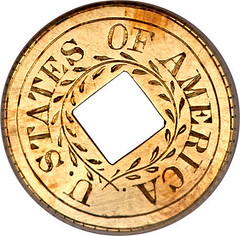 I enjoyed the March 6 E-Sylum article about a fascinating coin: "A Hand Engraved Gold Dollar Pattern." Yet I see Heritage Auctions' error was repeated: "...The reverse has a laurel wreath around the perforated center and outside that UNITED STATES OF AMERICA..."
I enjoyed the March 6 E-Sylum article about a fascinating coin: "A Hand Engraved Gold Dollar Pattern." Yet I see Heritage Auctions' error was repeated: "...The reverse has a laurel wreath around the perforated center and outside that UNITED STATES OF AMERICA..."
Look again: the coin reads U. STATES OF AMERICA - reminding me of Henry Voigt's "UNITED STATES OF AMERI." on the first Chain Large Cent. Why would James Longacre abbreviate the UNITED? Was the experienced designer unable to calculate the space needed? Or did he start at the end, with AMERICA, then work backwards to the UNITED and then realize he had run out of room? At first I thought he might be left-handed to do that, but his self-portrait (below) appears to show him right-handed (unless he was painting his mirror image!)
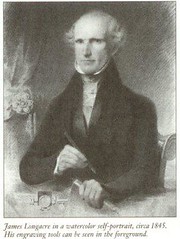 It harks to another old controversy: do left-handed engravers face their coin portraits to the left, to better sculpt the subject's eyes, mouth, etc. from the left; and right-handers face their portraits right, for the same reason? Or are engravers even given that choice? Ah, the mystery.
It harks to another old controversy: do left-handed engravers face their coin portraits to the left, to better sculpt the subject's eyes, mouth, etc. from the left; and right-handers face their portraits right, for the same reason? Or are engravers even given that choice? Ah, the mystery.
Keep up the interesting dialogues!
To read the earlier E-Sylum article, see: FEATURED WEB PAGE: A HAND-ENGRAVED GOLD DOLLAR PATTERN (www.coinbooks.org/esylum_v14n10a31.html)
ON WIRE, KNIFE AND ROLLED RIMS
Tom DeLorey writes:
Apropos Dick Johnson's comments on "wire edges," I would add that on coins (I cannot speak on medals) a more likely cause of wire edges is the slight misalignment of the hammer die, so that the outer edge of the die is not in perfect alignment with the inner edge of the collar. This creates a thin, crescent-shaped gap that metal can escape through, especially under multiple strikes such as a Proof would receive or a 1907 High Relief $20.
Over the years I have seen Morgan dollar Proofs that appear to have been very carefully trimmed around the rim, presumably to remove a wire rim. The precision and consistency of this trimming makes me believe that it was done at the Mint, though I cannot prove that.
Roger Burdette writes:
The term âwire edgeâ is a generally misunderstood term bastardized by Wally Breen and friends. It is implied as some sort of identifier of proof coins or coins with better than normal details. Synonym for âhokum.â
Coins do not have âwire edges.â The term is often misapplied to a âfinâ (or more descriptively a âfin rimâ). A fin rim is a very thin extrusion of metal ("flashing" is good, too) sitting above and at the other edge of the rim. It is a minting defect caused by a mismatch between planchet upset, planchet size and the edge collar-die diameter. It can occur at normal striking pressures as well as high ones.
The best known examples are Saint-Gaudens MCMVII $20 made through mid-December 1907. The defect was largely corrected through changes made to the upsetting of planchets from mid-December until the last pieces were struck.
An often confused, but unrelated term is âknife rim.â A knife rim occurs when the field of the die face curves directly to the edge of the coin. The result is a sharp knife-like rim rather than a normal flat rim. This is an intentional part of the design.
Lastly, one more misused term: ârolled edgeâ or ârolled rim.â As abused when referring to 1907 $10 from the 2nd hub, this is supposed to be some sort of special rim applied to the coins. Nonsense. It is nothing more than a normal not-quite-flat rim as found on coins made on production presses, as were the 2nd hub 1907 $10.
To read the earlier article, see: VOCABULARY WORD: WIRE EDGE (www.coinbooks.org/esylum_v14n10a12.html)
SARAH SOPHIA BANKS (1744-1818)
Joel Orosz writes:
Great issue of the big E. I had no idea that Sir Joseph Banks was such a significant collector of 18th century American coins. To the best of my knowledge, Sir Joseph never visited the U.S., so he must have had an American source who shipped them to him. I wonder who?
John Dannreuther writes:
 The British Museum donation was actually by Dr. Banks' sister, Sarah Sophia Banks and was later than 1800, but don't remember the exact date...believe it was around 1830 to 1840. There are some great items, including a gem 1795 eagle, a choice 1796 Stars quarter eagle, 1836 Proof quarter eagle, etc., besides the Colonials Alan mentioned. The little tags have SSB on them and some of the coins that Alan mentioned were not there on the two occasions that I visited (both within the last 5 years).
The British Museum donation was actually by Dr. Banks' sister, Sarah Sophia Banks and was later than 1800, but don't remember the exact date...believe it was around 1830 to 1840. There are some great items, including a gem 1795 eagle, a choice 1796 Stars quarter eagle, 1836 Proof quarter eagle, etc., besides the Colonials Alan mentioned. The little tags have SSB on them and some of the coins that Alan mentioned were not there on the two occasions that I visited (both within the last 5 years).
Saul Teichman writes:
With regard to the British Museum, they sent me an inventory many years ago of their early American holdings. This might be of interest to the E-Sylumites.
Collection name: S. S. Banks Collection
Donated by: Lady Dorothea Banks
Previous owner/ex-collection: Sarah Sophia Banks
Description: Silver coin.
Denomination: dollar
Weight 27.050gm
Date: 1795
Minted in: North America, USA
Women are relatively rare among the ranks of the major collectors. Sarah Sophia Banks (1744-1818) was the only sister of Sir Joseph Banks, the noted collector and patron of the circumnavigator Captain James Cook. She is portrayed in an unflattering cartoon by Gillray and is described as a dominant personality:
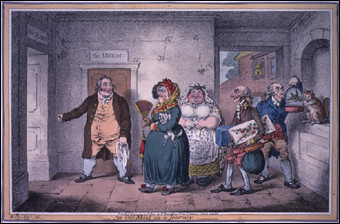
She had a loud, even strident voice, was tall and imposing, and cut an unmistakable figure striding along the streets or through the parks, always accompanied by a servant carrying a long cane... [she] drove a four-in-hand with the skill and confidence of a man, and was skilled in archery and fishing.
She was devoted to her brother and for many years lived with him and his wife, assisting in his work. A forceful and intelligent woman, lacking other outlets she assembled, in addition to coins, medals and books, a remarkable and pioneering collection of printed and engraved ephemera--now an immensely valuable reference collection for eighteenth century life.
This she bequeathed to her sister-in-law who presented it to the British Museum. The Department of Prints and Drawings now has about 19,000 items from Sarah Sophia's collection. In addition there are nine volumes of broadsides, newspaper cuttings and other prints in the British Library.
For more information on building the British Museum's collections, see: Rare Birds: Female Collectors and The British Museum (www.fathom.com/course/21701728/session3.html)
To read the earlier E-Sylum article, see: THOUGHTS ON THE BRITISH MUSEUM (www.coinbooks.org/esylum_v14n10a22.html)
QUERY: WHO WORKED AT STACK'S IN 1966?
The April, 1966 issue of Coinage magazine contained a photo story by Larry Stevens highlighting an Icon in the field of coin collecting in the United States. Titled COIN MECCA IN MANHATTAN included 21 photos of 123 West 57th Street, New York City home of Stackâs Rare Coin and Coin Galleries. At the time Stackâs had been in the coin auction field for just over thirty years, they have just celebrated their 75th anniversary.
The question is, who are the people of Stackâs in 1966? Some we all know, some names sound familiar and some I have never heard of.
So I pose this question to Harvey Stack to fill in the answers - I know he reads the E-sylum.
1. Joseph Petryk of the Burns Agency (security guard)
2. Harvey W. Nelson
3. George Weyr
4. Carol Bica
5. Harvey G. Stack (you look so young)
6. Lilo Strub
7. Henry G. Smith
8. Norman Stack (yes we all remember Norman)
9. Robert M. Jenove (identified as a dealer of Franklin Square, NY
10. Lawrence Maran family with son Andrew (custumers)
QUERY: FIRST THREE BASSO PHILIPPINE COIN ALBUMS SOUGHT
Ray Czahor writes:
Last week I was talking to David Lange, who is a noted author and researcher for NGC, who collected Philippine coins and is also a collector of coin albums and holders back into the 1930's. He is looking for examples of Philippine Albums he believes Aldo Basso had made and sold while he was located in California in the 1960's. David has a VOL IV and is looking for the first three volumes. They are entirely matte black with white printing and clear slides for viewing both sides of the coins.
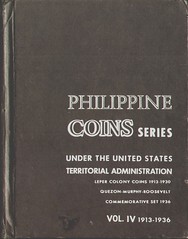
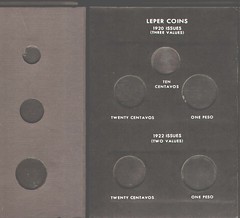
Here's an update from Dave, who writes:
It looks like I already found someone to trade me these albums for a couple of my books.
THE BOOK BAZARRE
MORE ON DAMASCENED MEDALS
Philip Mernick of London writes:
Regarding Dick Johnson's item about Damascened medals, I am sure he is wrong about them being late restrikes. As far as I know they are 18th century. I have a splendid Damascened Dassier medal of Martin Folkes, dated 1740, he was President of the Royal Society from 1741.
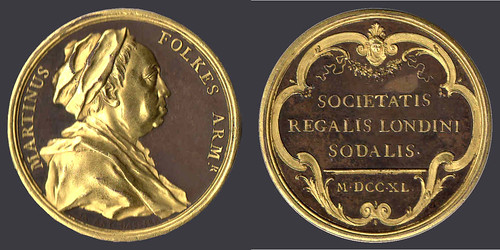
Philip contacted Chris Eimer, who writes:
I am with you on this, and unless I have completed misunderstood the matter, it has absolutely nothing to do with electro-plating.
In a nutshell, I believe the process to comprise the gilding, perhaps by gold leaf, of the entire surface of the medal, after which those areas of the surface which do not constitute the relief have the gilding or leaf removed. And yes, they most certainly constitute part of the original issue.
To read the earlier E-Sylum article, see: NUMISMATIC VOCABULARY: DAMASCENE (www.coinbooks.org/esylum_v14n09a05.html)
MORE ON F. GORDON FROST
Howard A. Daniel III writes:
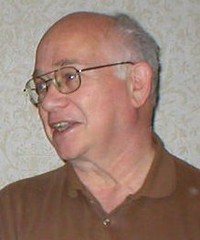 I was very sad to learn Gordon passed away. I first met him about ten years ago at an ANA Convention during the NBS meeting and we met at almost all of them since. After the first NBS meeting, he returned to my club booth with me and we talked for many hours. Gordon had nothing to hide and he was very up front with everyone. His passion for books was VERY real and he especially liked books about Treasure Finds.
I was very sad to learn Gordon passed away. I first met him about ten years ago at an ANA Convention during the NBS meeting and we met at almost all of them since. After the first NBS meeting, he returned to my club booth with me and we talked for many hours. Gordon had nothing to hide and he was very up front with everyone. His passion for books was VERY real and he especially liked books about Treasure Finds.
When sitting at my club booth and someone came to it that also liked books, he would put a hammer lock on him (only kidding!). The person rarely departed before 30-60 minutes with Gordon. He always knew something about each person's specialty because he likely had many references about it in his library and had read every one of them!
I never found anything for him that he did not already have in his vast library but he did find several for me. Gordon will be greatly missed by me!!!
Frank Campbell writes:
One of the great pleasures of serving as ANS Librarian was having the chance to meet a great number and variety of Library visitors. With the passing of F. Gordon Frost, one of my favorite visitors is gone but, as they say, the memories linger on. To borrow from my very limited Yiddish vocabulary, which all true New Yorkers possess to some degree, Gordon was a mensch. When he visited the library, his purpose was generally to give, as much as it was to receive.
When I was late in ordering a copy of Pete Smith's "American Numismatic Biographies," and mentioned to Gordon that I was having trouble finding a copy, he took it upon himself to find me one. If I lacked the current edition of a standard guide such as David and Frank Sedwick's, "The practical book of cobs," Gordon was there to remind me of it.
When Gordon, together with David Crooks, founded the Sunken Treasure Literature Club, he made sure that the Library was kept aware of new publications in this specialized area, such as "Bibliography of sunken treasure books with annotations ... ," by Crooks.
Gordon also had a special liking for chocolate, and so, his visits to the Library also meant that the Librarian would, invariably, be offered a piece. We were both born under the sign of Gemini. On March 6th, the day of Gordon's burial, as his family, I, and many other of his friends, stood in the rain at his graveside, I know that I and all those present, were seeing him off to a place where clouds don't gather and the sun always shines.
Scott Rubin writes:
I was very saddened by the news of Gordon Frost I will still expect him when I go to the next New York City coin auction.
SOME PHOTOS OF STEVE TANENBAUM
Last week Dave Wnuck of Coin Rarities Online asked if anyone could supply a photo of the late Steve Tanenbaum to illustrate a tribute to Steve on his web site. I noted that a photo of Steve appeared in the March 7, 2011 issue of Coin World. Thanks to CW Editor Beth Deisher, both Dave and The E-Sylum can now publish the photo. Photo Credit: Coin World Magazine, with permission from the Tanenbaum family. Here it is (below, left)
âAlso, the below photo of Steve (below, right) at his bourse table was taken by Q. David Bowers at the March 2005 Baltimore Coin & Currency Showâ

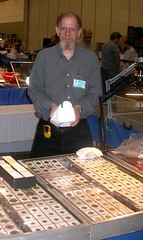
To read the earlier E-Sylum article, see: MORE ON STEVE TANENBAUM (www.coinbooks.org/esylum_v14n10a16.html)
QUERY: REVIEWS OF MOSSMAN BOOK SOUGHT
Regarding Kraljevich's article on Literature on World Coins Circulating in Early America, Robert Neale writes:
I wish the info on Phillip Mossman's book cited in the Kraljevich article could have appeared a few months ago. The reason: I just presented an illustrated community talk in which I covered the confusing mixture of coins and paper money that might have resided in the pockets and tills of our colonial Americans during the century of years starting in 1690. I finished with examples of the first new coinage of the newly constituted United States and how they were born from Thomas Jefferson's original proposal.
While obtaining high quality projectable images of the subjects of my overview was time consuming, the greater challenge was sorting out the mélange of coins and paper with which the colonists had to deal, their varying relative values, and the problem of accounts kept in the English system but usually settled in other monies. I suspect that Mr. Mossman's book would have been a real time saver in researching those 100 colonial years, a check on the information secured elsewhere, and a source of many additional and interesting facts.
So, better late than never, I'm considering purchase of a used copy of Money of the American Colonies and Confederation (for at least $50), and I wonder whether any readers can attest to John Kraljevich's glowing recommendation of Mr. Mossman's volume before I lay out the dough?
NOTES FROM E-SYLUM READERS: MARCH 13, 2011
U.S. Mint Adjusts Silver Prices
Adrián González Salinas writes:
I read the following interesting notice about the "2010 America the Beautiful Quarters Silver Proof Set".
Investors and coin collectors are not the only ones taking a new look at silver coins with the price of silver at levels not seen in over thirty years. The US Mint is reevaluating the prices for its silver products.
In fact, the US Mint has halted sales of one of its silver related products, namely the 2010 America the Beautiful Quarters Silver Proof Set. As of last week, the set could no longer be ordered. A short notice was placed on the Mint's online store stating: "This product is temporarily unavailable."
To read the complete article, see: (http://www.silvercoinstoday.com/us-mint-reevaluates-silver-coin-prices/103915/)
Borders Books
Philip Mernick writes:
Regarding Borders creditors, I am one, at least of Borders UK! They keep sending me paperwork although I don't remember ever making a claim. This must be in my role of publishing local history books (East London History Society). I think we sold ONE book, years ago, to a London bookstore that was part of the Border's organisation although I didn't know it at the time. Anyway, we never got paid but I didn't get too upset over a debt of less than ten dollars! Now they have told me that as an unsecured creditor I won't get paid - I don't think I will lose any sleep over it.
Edwin Johnson writes:
My significant other has worked as a Borders Bookstore manager for ten years and has worked at other bookstores since the mid-1980s. It is absurd to claim (especially without a shred of evidence to back it up) that Borders Books managers would prevent the sale of books. The job of a bookstore manager is to sell books, not to prevent them from being sold, for that's what pays their salaries.
Occasionally, paranoid customers come into my significant other's store and falsely claim that so-called conservative books are being banned at that store, yet there are gigantic displays of such books right as they walk in the door. Not only that, but many so-called conservative authors, such as Sarah Palin, have held book signings at Borders Books, as I've witnessed myself.
To read the earlier E-Sylum article, see: BORDERS BANKRUPTCY - WHO GETS STIFFED? (www.coinbooks.org/esylum_v14n09a10.html)
Clinton's Vietnam Challenge Coin
Ken Berger writes:
 Other than the "butterfly" shoulders on the woman's dress, I see nothing to indicate that the two individuals on President Clinton's Challenge Coin are Filipinos. The man's shirt is definitely not a standard Barong Tagalog (the national formal dress for men). There is a Barong Tagalog with a Mandarin collar (which it seems to resemble), however I have never met a Filipino wearing such a barong. Even my barongs are of the standard type. (Perhaps the Mandarin collar style is more common among the Chinese mestizos.) Also, you will note that the man's collar appears to have a button on it. A barong with a Mandarin collar does not have such a button.
Other than the "butterfly" shoulders on the woman's dress, I see nothing to indicate that the two individuals on President Clinton's Challenge Coin are Filipinos. The man's shirt is definitely not a standard Barong Tagalog (the national formal dress for men). There is a Barong Tagalog with a Mandarin collar (which it seems to resemble), however I have never met a Filipino wearing such a barong. Even my barongs are of the standard type. (Perhaps the Mandarin collar style is more common among the Chinese mestizos.) Also, you will note that the man's collar appears to have a button on it. A barong with a Mandarin collar does not have such a button.
It is possible that the hats worn by the two individuals belong to one of the many different tribal groups. However, if this is the case, then the woman would not be wearing a butterfly dress. The tribal groups would wear their appropriate headgear with the appropriate tribal costume, not with a butterfly dress which is a more modern form of attire.
Thus, I disagree with Howard A. Daniel III and I am far from convinced that the individuals depicted on the challenge coin are Filipinos. At the very best, the individuals represent a composite of different Southeast Asian peoples.
To read the earlier E-Sylum article, see: PRESIDENT CLINTON VIETNAM VISIT CHALLENGE COIN (www.coinbooks.org/esylum_v14n10a18.html)
The Numismatic Museum of Athens
Bob Knepper writes:
Thank you, Wayne, for forwarding the info from Dr. Howard Berlin about the Numismatic Museum of Athens, and thanks to him for the info.
I sent an email to Ms. Efterpi Ralli at nma@otenet.gr on February 27. Unfortunately there has been no response to that email nor to my question sent via the response feature on the Numismatic Museum of Athens website nor to an email to a different museum address. Thus I am suspicious that the museum may be closed because of Greece's economic problems. Also possible that the museum staff has been reduced so they cannot answer inquiries - or have a long response time.
Oh well, the modern Greek pattern and off-metal coins are probably too expensive for me anyway and undoubtedly hard to find. I hoped to look at pictures to determine which include the Wildman figure in which I specialize.
HERBERT IVES AND THE AMERICAN NUMISMATIC SOCIETY
Earthquakes new and old are in the news this week. A few days before the devastating quakes in Japan, it was announced that the first known color photographs of San Francisco following the 1906 earthquake had been found. They are at once beautiful and eerie, especially in a world used to seeing that era through the lens of a black-and-white camera. No, kids, the world did not used to be in black-and-white, although that's an easy assumption to make.
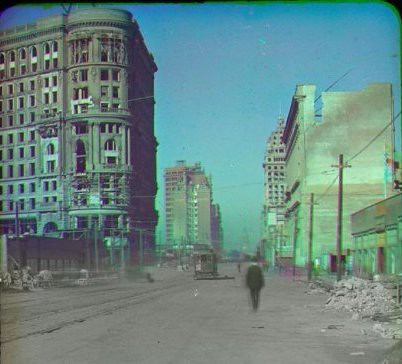
The first numismatic connection I thought of was the San Francisco Mint, the only government structure to survive the quake. But alas, I did not find an image of the Mint among the discovered photos (there are only six of them).
The photos were taken by a man named Frederick Ives, and Michael Bates asked Robert Hoge of the American Numismatic Society whether this might be the same Ives family connected with the ANS. Turns out, it is.
Robert Hoge writes:
Here is material on Herbert taken (with a few corrections and modifications) from the ANS website, at www.numismatics.org. As you are probably already well aware, the ANS is in the process of making some exciting upgrades to our data base offerings. This might help to highlight something of our approach. Within a few weeks people will probably be quite surprised by the ongoing improvements! Both Herbert and Frederick Ives were American geniuses who contributed immensely to modern civilization. These great achievements and a wonderful public spirit is are reflected in the splendid collections bequeathed to the American Numismatic Society. Many wealthy collectors disperse their holdings or set up their own private foundations to retain them. Only a few great souls place their coins and other materials in a context where they can be truly appreciated and accessed by all who share an interest.
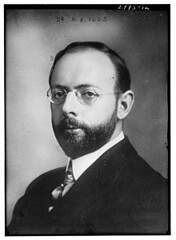 Herbert E. Ives (1882-1953) was born in Philadelphia on July 21, 1882. His father, Frederic Ives, was a distinguished scientist who had invented techniques for color photography and the half-tone process which made it possible to reprint photographs in magazines and newspapers. The younger Ives attended the University of Pennsylvania, where he earned his bachelors degree in 1905, and Johns Hopkins University, where he earned his doctorate of philosophy in 1908.
Herbert E. Ives (1882-1953) was born in Philadelphia on July 21, 1882. His father, Frederic Ives, was a distinguished scientist who had invented techniques for color photography and the half-tone process which made it possible to reprint photographs in magazines and newspapers. The younger Ives attended the University of Pennsylvania, where he earned his bachelors degree in 1905, and Johns Hopkins University, where he earned his doctorate of philosophy in 1908.
Upon graduation, Ives held a series of positions in industrial research, but his greatest successes came during his tenure at Bell Laboratories, which he joined in 1919 after serving in the U.S. Army Signal Corps during World War I, where he did early work in aerial photography. It was during his years at Bell that Ives became known as one of the world's leading electron-optical physicists. His research accomplishments were numerous and resulted in:
- the first demonstration of television (both black & white and color);
- the first practical lamp for the production of artificial daylight (i.e., night vision);
- the first demonstration of two-way television; and
- the development the process of transmitting pictures over telephone lines, which became the wirephoto process subsequently used by newspapers.
During World War II he received the Medal for Merit â" the nation's highest civilian honor â" for his work on night-vision devices during that conflict. By the time of his retirement from Bell Labs in 1947, Ives had published more than 200 papers and secured more than 100 patents.
Ives joined the ANS as an associate member in April 1924. By 1925, he had been elected a Fellow. In 1937, Ives was named a Patron of the ANS because of his gift to the Society of twenty-two medals awarded to his father for his scientific accomplishments. (An outstanding group of medals)
Ives was first elected to the ANS Council in January 1934 and remained on the Council until his death in November 1953. While on the Council, Ives served on various committees including: Medals, European Coins, and Publications. He chaired the latter committee from 1947 until 1951 during which the Society launched its bibliographic publication, Numismatic Literature.
Ives' numismatic interests focused on three types of gold: English nobles, Venetian ducats, and Florentine florins. He published three significant works on these subjects:
Foreign Imitations of the English Noble, Numismatic Notes and Monographs, no 93, 1941.
"The Design of Florentine Florins as an Aid to Their Dating," ANS Museum Notes, v. 5, 1952.
The Venetian Gold Ducat and its Imitations, Numismatic Notes and Monographs, no. 128, 1954.
The last work was edited and annotated by Philip Grierson and published posthumously, inasmuch as Ives had died on November 13, 1953. Upon his death, Ives bequeathed to the ANS his extensive collection of gold coins.
To read the complete article, see: Color pics of San Francisco after '06 quake found (news.yahoo.com/s/ap/20110310/ap_on_re_us/us_great_quake_in_color)
GAO RECOMMENDS REPLACING DOLLAR NOTE WITH COINS
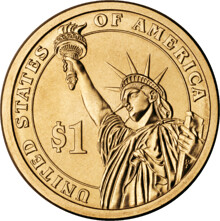 European Union members no longer have it, the British no longer have it, and the Canadians no longer have it.
European Union members no longer have it, the British no longer have it, and the Canadians no longer have it.
None of these nations have the single unit of their currency available on a paper bill â" itâs in coin form only. Thereâs no longer such a thing as a 1 euro, 1 British pound, or 1 Canadian dollar banknote. Why? It saves their governments a lot of money.
Now, the US Government Accountability Office says itâs time to phase out the paper version of the US $1 note. According to GAOâs analysis, âreplacing the $1 note with a $1 coin could save the government approximately $5.5 billion over 30 years. This would amount to an average yearly discounted net benefitâ"that is, the present value of future net benefitsâ"of about $184 million.â The savings comes from the fact that coins last much longer than paper currency.
To read the complete article, see:
Goodbye US dollar banknote? Government report urges move to coin only
(www.smartplanet.com/business/blog/business-brains/
goodbye-us-dollar-banknote-government-report-urges-move-to-coin-only/14119/)
To read the original GAO report, see: Replacing the $1 Note with a $1 Coin Would Provide a Financial Benefit to the Government (www.gao.gov/new.items/d11281.pdf)
EDITORIAL COMMENTS ON ABOLISHING THE $1 BILL
The Baltimore Sun ran an article and an editorial this week on the same subject: The U.S one-dollar bill. Should the paper dollar be abolished in favor of wider circulation of one-dollar coins?
Here, again, this is a plan to attack only one arm of our monetary system. Any piecemeal solution is bound to fall flat. What is needed is a complete overhaul of all U.S. coins. I will not comment about our paper currency as I have not studied it.
But study coins I have. With an eye to what coins should we have in the future -- most significantly what denominations -- I foresee what those should be, their composition, size and other features. I studied every aspect, even the intended death of every coin, retired from circulation such as scrapping, melting, and recoining. The historical records of coinages of the past need to be matched to the needs of coinages of the future for the most efficient use by every citizen, and every level of commerce.
There are so many factors, and an over abundance of lobbying, that Congress, the ultimate arbitrator of the problem, is hesitant to make any decision.
It was interesting to read the public comments to the Sun's editorial. If you are interested you can click on to:
Dollar coin could save U.S. more than pocket change
(www.baltimoresun.com/news/opinion/readersrespond/
bs-ed-dollar-coin-20110309,0,7217131.story)
WAYNE'S NUMISMATIC DIARY: MARCH 13, 2011
Tom Kays was our host for this month's meeting of my northern Virginia numismatic social group, Nummis Nova. He picked an interesting location - The Mount Vernon Inn. On the grounds of George Washington's home, the Inn is connected to a visitor's complex which includes a museum and the obligatory gift shop.
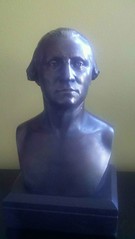 It was a pleasant, scenic drive down from the Beltway along the Potomac River. I arrived early, parked my car and decided to kill time in the gift shop. I ended up making a purchase - a small-scale "bronze" reproduction of Houdon's famous bust of Washington. A little under a foot tall, it's a faithful reproduction. I put "bronze" in quotes because even though it looks bronze I'm not really sure what it's made of. For a $55 souvenir made in China, I wasn't expecting much. But I like it. Even though it had already been wrapped and packed, when I got to the Inn I took it out and placed it on our table in front of me. Now it sits on a file cabinet in my home office and library.
It was a pleasant, scenic drive down from the Beltway along the Potomac River. I arrived early, parked my car and decided to kill time in the gift shop. I ended up making a purchase - a small-scale "bronze" reproduction of Houdon's famous bust of Washington. A little under a foot tall, it's a faithful reproduction. I put "bronze" in quotes because even though it looks bronze I'm not really sure what it's made of. For a $55 souvenir made in China, I wasn't expecting much. But I like it. Even though it had already been wrapped and packed, when I got to the Inn I took it out and placed it on our table in front of me. Now it sits on a file cabinet in my home office and library.
The Inn was built in the 1930's in Colonial style. Although some of our members had been warned about the food, I think everyone came away pleased. Several of us started with the peanut and chestnut soup, which was very tasty. Gene shared a bottle of Mt. Vernon Merlot with me (thanks!). He thought it was too sweet for his taste, but I liked it.
When I arrived some folks were already there, including a gentleman I initially mistook for Gene Brandenburg. It was Ron Abler, a longtime E-Sylum subscriber and contributor. It's always great to meet email pen pals in person and finally put a face to the name. I sat next to him and we talked a good bit about his collection and research into Centennial Medals of the United States. Ron recounted his first meeting with Joe Levine, when Joe kindly took an hour to patiently answer his questions about medals after he'd gotten the collecting bug.
Next to Ron was our host Tom Kays, well prepared as always with a lighted magnifying glass stand and a show box of interesting coins. He also had a photo of a group of coins whose story blew everyone away. A hoard of early U.S. and colonial-era circulating coins from many countries, the group had been discovered just within the past week along the banks of a local river. The most recent coin was dated 1810. Tom had a plausible theory of when and by whom the hoard was deposited, and he's working on an article about it. The find was even more timely given the item in last week's E-Sylum about the "Mudlarks" who look for artifacts along the Thames River in London.
Other attendees were Gene Brandenburg, Dave Schenkman, Joe Levine, Howard Daniel, Mike Packard, Chris Neuzil, Jon Radel and Bill Eckberg.
I'd missed last month's meeting and Bill brought some things he'd been holding for me. They were chocolate coins and medals, another earlier E-Sylum topic. There were four chocolate U.S. coppers (large cent and half cents) molded from real coins. Bill had these made for an earlier Early American Coppers convention (these were described in an earlier E-Sylum).
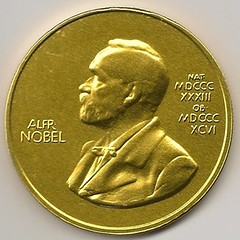 The other item was a chocolate version of the Nobel Prize medal. Bill had purchased it in a museum gift shop in Stockholm. He visited Sweden while tracking his family history. I'm part Swedish myself, although I haven't traced our history that far back. My grandfather was Olof Gustave Homren.
The other item was a chocolate version of the Nobel Prize medal. Bill had purchased it in a museum gift shop in Stockholm. He visited Sweden while tracking his family history. I'm part Swedish myself, although I haven't traced our history that far back. My grandfather was Olof Gustave Homren.
There were plenty of numismatic books in addition to coins. I'd brought the Japanese version of Whitman's Modern World Coins and a copy of Moneymakers by Ben Tarnoff, the new book on U.S. counterfeiting.
Already being passed around the table when I arrived were two books brought by Mike Packard. The first was Chris Salmon's new book on Massachusetts Silver coins. It's a big, beautiful book and seems well worth the wait. Bill Eckberg brought one of these, too. I'm still waiting for mine. Apparently they are being shipped in batches from China, and my number hasn't come up yet. Would anyone care to write up a review for The E-Sylum?
The other book was created in an edition of just 22 copies by Ray Williams. It documents the exhibit of U.S. colonial coins displayed at the 2010 American Numismatic Association convention. The books were given to the contributors who loaned coins to the exhibit. The book was hardcovered and contained images of the coins and exhibit, along with the exhibit text and credits. But now I've got a hole in my colonial shelf I may never be able to fill. Still, what a great idea! Kudos to Ray and the Colonial Coin Collectors Club (C4) for a job well done.
Tom Kays passed around a copy of another great new book, the 2nd edition of Chris Eimer's British Commemorative Medals and their Values. Who will write a review of this one?
It was a memorable meeting, and I'd be more than happy to go back sometime. I overheard someone ask, "Did you see the Society of the Cincinnati medal in the museum?" My jaw dropped. Better get there REALLY early next time. We're lucky to have so much history right in our backyard, and all of us are fortunate to have such a great group of fellow numismatists to share an evening with on a monthly basis. If you don't have such a group in your town, consider starting one!
1937 KING GEORGE VI GOLD MATT PROOF COINS
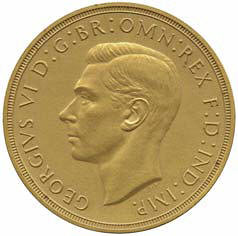
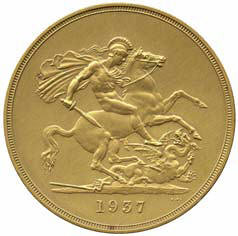
Following the phenomenal success of the British spectacular The Kingâs Speech at the Oscars Baldwinâs latest auction consignment couldnât have come at a more appropriate time. Offered in its original Royal Mint case, a set of four 1937 Gold, Matt Proof finish coins, commissioned to commemorate the Coronation of King George VI, are sure to be the highlight of the Baldwinâs London auction, due to be held in May this year.
The set, which carries a weighty estimate of £90,000 â" 110,000, is one of only two known sets struck with an experimental matt finish specifically to be used for pre‐production promotion of the coins minted by the Royal Mint to commemorate the Coronation of the King in May 1937.
In 1936, when the new designs were in gestation, numismatic photography was in its infancy. The reflective properties in the gold metal used to mint coinage made it impossible to generate a clear image of each coin. The Royal Mint successfully experimented with matt finishes produced from a sand‐blasting process to generate these pre‐production coins which were used to advertise new coins to the public.
This set would have been one of the first to be produced solely for that purpose. One of only two of its kind known to exist in private hands, the case housing the coins has a black velvet pad, inverse in colouration to the normal cream used for brilliant proof sets in 1937. Unlike its counterpart (illustrated individually in Wilson and Rasmussen), this beautifully preserved set has its original and unusual case intact.
The set comes complete with a copy of a letter, dated 4th October 1961, from the Royal Mint, Tower Hill, London, outlining the method and process for preparation of the set and confirming that the set was a pre‐production example that was not released to the general public.
George VI is now well known for his speech impediment, apparent in the early recordings of his public speeches, which has become the storyline for this years BAFTA and Oscar award winning film, The Kingâs Speech. The stammer plagued him in his role as a public speaker throughout the first ten years of his reign.
He sought ongoing help from the Australian speech therapist, Lional Logue, and eventually overcame his affliction. King George and his wife, Queen Elizabeth, became a well loved Royal couple, famously refusing to leave the environ of Buckingham Palace during the Blitz, even when it was bombed.
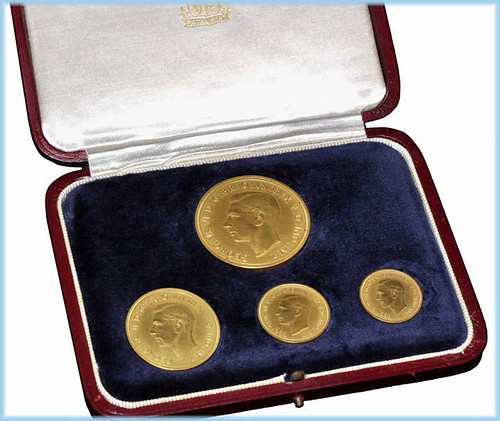
THE BOOK BAZARRE
THE BANK OF GREECE MUSEUM
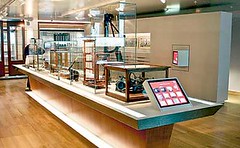 Thereâs not much to catch the eye at 3 Amerikis Street in central Athens, though this is where the National Bank of Greece houses its museum.
Thereâs not much to catch the eye at 3 Amerikis Street in central Athens, though this is where the National Bank of Greece houses its museum.
The museumâs current exhibition is on Greeceâs numismatic history. It is free of charge and is proving to be very popular, especially among younger visitors, who are captivated by the clever exhibits.
The first exhibit is an attention grabber: It is a large installation consisting of five transparent boxes containing 1.5 million euros. Visitors crane their necks to make out the bills they expect to see, but this exhibit highlights the euroâs environmentally friendly character by showing the stuff that itâs made of rather than the bills themselves: cotton fibers.
Another exhibit is one of the most ancient coins in the bankâs collection: a small electrum coin from Chios featuring the emblem of the island, a sphinx.
Displays of banknotes from other parts of the world are also impressive. There are banknotes from Cuba adorned with portraits of Che Guevara, from India with Mahatma Gandhi and from Zaire, featuring a gorilla. There is also the first-ever banknote printed, which hails from China and comes with a warning to forgers that they will suffer a terrible punishment if caught.
The basement level of the museum contains displays of bank bonds, including a fascinating bond depicting a female figure with two children and another for 100 billion drachmas. The designs for the bonds, all done by hand and in incredible detail, are kept in drawers that can be opened by visitors, while there are also special display cases showing the templates and shedding light on the fine etchings and prints that were used. Angelos Xenos, the head of the service in charge of the bankâs archives and collections, is at hand to talk visitors through a display of all the tools and instruments used by those who designed and made banknotes and bonds.
It goes without saying that the most popular displays are the gold ingots and coins. The visual delight of the sparkling, well-polished gold bars is complemented by an audio stimulant as well, as the sound of tinkling coins from Pink Floydâs landmark song âMoneyâ plays in the background. On a similar pop culture note, there is a projection of the miserly cartoon character Scrooge McDuck taking a dive into a pile of gold coins, as well as a massive photograph of the central bankâs vault -- with security-sensitive details photoshopped out, of course.
To read the complete article, see: Money: It's a hit at the Bank of Greece museum (www.ekathimerini.com/4dcgi/_w_articles_wsite4_1_11/03/2011_382533)
SPAINISH TOWN REINTRODUCES PESETAS TO BOOST ECONOMY
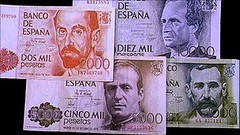 A small town in northern Spain has decided to reintroduce the old Spanish currency - the peseta - alongside the euro to give the local economy a lift.
A small town in northern Spain has decided to reintroduce the old Spanish currency - the peseta - alongside the euro to give the local economy a lift.
Shopkeepers in Mugardos want anyone with forgotten stashes of the old cash at home to come and spend it.
It is nine years since the peseta was official currency in Spain.
But Spain's economic crisis has forced some to be inventive. The hard times have seen thousands of businesses close and more than two million jobs go.
More than 60 shops in Mugardos, a small fishing town in Galicia on Spain's northern coast, are accepting the peseta again for all purchases, alongside the euro.
It is an attempt to get cash registers ringing - and help lift the town out of a long and painful economic slump.
Shopkeepers were sceptical at first, but they now say the scheme is a great success.
People are travelling into Mugardos from outside just to spend the old currency they never got round to converting.
One man visited the local hardware store this week with a 10,000-peseta note he had found at home, and had no idea what to do with.
He is now the happy owner of a sandwich toaster.
To read the complete article, see: Spain town reintroduces peseta to boost economy (www.bbc.co.uk/news/world-europe-12657225)
SRI LANKA'S 2011 AIR FORCE COMMEMORATIVE COIN
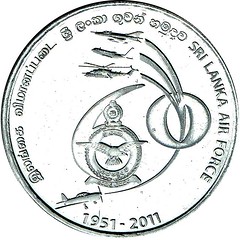
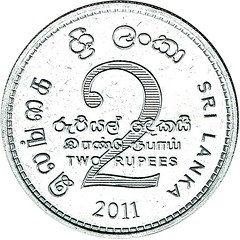
The Sri Lanka Air Force (SLAF) completed 60 years and to mark the event, the Central Bank of Sri Lanka issued a commemorative two rupee coin into circulation on March 2. The coin is minted to the existing standard of a Rs 2 coin which is nickel plated steel and issued only in circulation condition by the Royal Mint, Liantrisant, United Kingdom.
The obverse has the logo of the Sri Lanka Air Force 60th Anniversary at the centre and the years `1951-2011' below. The words SRI LANKA AIR FORCE in Sinhala, Tamil and English appear at the top, left and right sides along the periphery.
The logo has a large 60 with the Armorial Ensign of Sri Lanka Air Force on the 6. There is also an artist's impression of four planes used by the Sri Lanka Air Force. Below is the Chipmunk, used in its early days, and above are a Mil Mi-24 ground attack helicopter, Hercules C-130 transport aircraft and a F7 GS Thunderbolt fighter used currently. The reverse is the standard Rs 2 coin with the date 2011.
The obverse of the coin designed by the Sri Lanka Air Force has clearly been inspired by the 50th anniversary logo. The 50th anniversary Air Force 1 rupee coins of which only 2000 were minted and only 800 released to the public in 2001 March at Rs 600 was sold out in under one month. It is the most difficult Sri Lanka commemorative coin to find and is now sold by dealers for over Rs 15,000 if any come on the numismatic market.
The decision to issue the new coin was made too late to have them minted in time of the opening of the 60th Air Force Anniversary exhibition. An advance lot of only 93 coins arrived on March 1, just in time for a few to be gifted to President Mahinda Rajapaksa and few other dignitaries at that event. A press release issued by CBSL on March 7 states that coins will be issued to public circulation in April 2011. Mintage is listed as three Million in a docket printed by the Air Force.
To read the complete article, see: 60 years of flying high sealed with a coin (www.sundaytimes.lk/110313/Plus/plus_11.html)
For more information, see the coin's page on Kavan's web site: 2011 - Sri Lanka - 2 Rupee Sri Lanka Air Force 60th Anniversary (coins.lakdiva.org/commemorative/2011_airforce60_2r.html)
JAPANESE "MONEY ARTIST" YASUMASA MORIMURA
"I find money and art have something in common. Money, over which humans fight, is nothing more than paper for animals. Similarly, art can carry great meaning or say nothing. People praise the Mona Lisa, for example, but one could also say it is little more than a piece of cloth. Once we become caught up in their perceived values, we fall for them. In this way, the two things are very similar," says artist Yasumasa Morimura.
"I've long been examining the relationship between artistic expression and money--or more precisely, paper money. In 1991, I made my first work based on this idea, using a 1,000 yen bill, using my own image [to replace that of Soseki Natsume]. But this is the first time I've ever exhibited my bank note work in a comprehensive way," the artist tells The Daily Yomiuri, referring to Morimura Yasumasa--Shozo Keizai, Sonota (Yasumasa Morimura: Self-portrait of economy), which opened last week at BLD Gallery in Ginza, Tokyo.
Morimura is best known for his self-portraits in which he places his visage in famous images of everything from actresses and revolutionaries to characters from well-known works of art as featured in his Requiem series, which began with his 1985 re-creation of a Van Gogh self-portrait. He has reinterpreted self-portraits and other art by masters diverse as Velazquez, Goya, da Vinci and Monet.
In discussing the similarities between these seemingly disparate objects (money and art), he also stresses their differences. "Although good or unusual design is held in high regard, these factors don't affect a bill's financial value. They are valued purely for their face value, with the exception of antique bills. So they are very different in that respect."
While working on his Requiem series, Morimura says he was surprised to discover that many of the historical figures whose portraits appear on our currency are not only representatives of the 20th century, but in a broad sense, revolutionaries.
"Take Che (Ernesto Guevarra), Mahatma Gandhi, Vladimir Lenin, Albert Einstein and Mao Zedong. Each of these people strove for something, believed there were things that money couldn't replace," Morimura said. "But in the end, they literally became part of money. I find that both interesting and ironic, and it gave me a lot to think about."
In addition to the seven revolutionary figures listed above whose guise Morimura donned for the portraits, and the original 1,000 yen-bill based work, Shozo Keizai also explores currency from Italy, the Netherlands and Mexico, which carry the images of Caravaggio, Rembrandt and Frida Kahlo, respectively. Morimura said the three are reflective of three persistent questions.
In the case of the Italian bill, Morimura said he wanted to express the notion that the desire for love or beauty--or an aesthetic consciousness--overcomes the idea of abstinence or morality, as Italy did not hesitate to put on its currency the face of an artist who was known as an outlaw. "Caravaggio was a bad guy and murderer. Still, he was chosen as the image of printed matter produced with national credit."
To read the complete article, see: Personality cash: Yasumasa Morimura explores the revolutionaries on our money (www.yomiuri.co.jp/dy/features/arts/T110310006810.htm)
METAL DETECTORIST'S LEICESTER GOLD COIN FIND
 Amateur treasure hunter Steve Bestwick could be quids in after discovering a stash of 2,000-year-old gold coins, worth at least £3,000, in a field in Leicester.
Amateur treasure hunter Steve Bestwick could be quids in after discovering a stash of 2,000-year-old gold coins, worth at least £3,000, in a field in Leicester.
Bestwick, who bought a metal detector after being inspired by archaeology show Time Team, unearthed ten gold coins from farmland after spending years searching for treasure.
The coins, which are being valued at the British museum, are thought to be worth at least £3,000.
âIn terms of archaeology, this is like winning the lottery. I just couldnât believe my luck,â said the 55-year-old, from Wigston, Leicestershire.
âI always go out with hope in my heart but end up with junk in my pocket. This time it was different. The coins arenât British â" we think they originate from northern France â" so itâs a bit of a mystery how they ended up in Leicester.
âItâs likely that they could have been given to a British warrior who worked as a mercenary â" the Anglo-Saxons were known for their fearless fighting and often employed to fight for foreign rulers.â
To read the complete article, see:
Treasure hunter strikes gold by unearthing 2,000-year-old coins
(www.metro.co.uk/news/857562-treasure-hunter-strikes
-gold-by-unearthing-2-000-year-old-coins)
To read the earlier E-Sylum article, see: ARTICLE DISCUSSES THAMES RIVER NUMISMATIC FINDS (www.coinbooks.org/esylum_v14n10a25.html)
FEATURED WEB SITE: THAMES MUDLARKS
This week's Featured Web Site is the Thames and Field Metal Detecting Society

Regarding the Reuters article on the Thames Mudlarks who search the riverbanks for artifacts, Eric Vanhove writes:
The author got the Mudlark link wrong. It's www.thamesandfield.co.uk .
www.thamesandfield.co.uk
